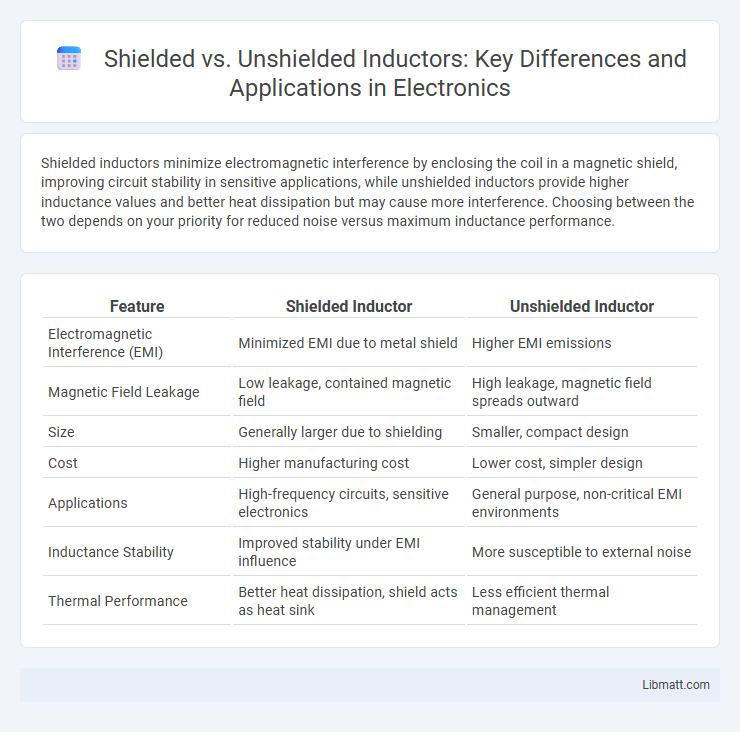Shielded inductors minimize electromagnetic interference by enclosing the coil in a magnetic shield, improving circuit stability in sensitive applications, while unshielded inductors provide higher inductance values and better heat dissipation but may cause more interference. Choosing between the two depends on your priority for reduced noise versus maximum inductance performance.
Table of Comparison
| Feature | Shielded Inductor | Unshielded Inductor |
|---|---|---|
| Electromagnetic Interference (EMI) | Minimized EMI due to metal shield | Higher EMI emissions |
| Magnetic Field Leakage | Low leakage, contained magnetic field | High leakage, magnetic field spreads outward |
| Size | Generally larger due to shielding | Smaller, compact design |
| Cost | Higher manufacturing cost | Lower cost, simpler design |
| Applications | High-frequency circuits, sensitive electronics | General purpose, non-critical EMI environments |
| Inductance Stability | Improved stability under EMI influence | More susceptible to external noise |
| Thermal Performance | Better heat dissipation, shield acts as heat sink | Less efficient thermal management |
Introduction to Inductors
Inductors are passive electronic components designed to store energy in a magnetic field when electrical current passes through them. Shielded inductors contain a magnetic core encased in a shielding material to minimize electromagnetic interference (EMI), making them ideal for sensitive circuits. Unshielded inductors lack this protective casing, which can lead to increased EMI but often feature simpler construction and lower cost.
What is a Shielded Inductor?
A shielded inductor is a type of inductor enclosed within a magnetic shield that minimizes electromagnetic interference and reduces magnetic flux leakage. This design enhances performance by preventing coupling with nearby components, making shielded inductors ideal for high-frequency circuits and compact electronic devices. Your choice of a shielded inductor ensures improved signal integrity and reduced noise in sensitive applications.
What is an Unshielded Inductor?
An unshielded inductor is a type of inductor that lacks a magnetic shield around its coil, allowing magnetic fields to extend freely into the surrounding environment. This design results in higher electromagnetic interference (EMI) susceptibility but typically offers lower cost and simpler construction. Understanding the characteristics of unshielded inductors helps you choose the right component for applications where minimal shielding is acceptable, and space or cost constraints are critical.
Key Differences: Shielded vs Unshielded Inductors
Shielded inductors have a magnetic enclosure that confines the magnetic field, reducing electromagnetic interference (EMI) and allowing closer placement to other components on your PCB. Unshielded inductors lack this enclosure, causing higher EMI emissions and potential coupling with nearby circuits, which can affect signal integrity and performance. Choosing between shielded and unshielded inductors depends on your circuit's noise sensitivity, space constraints, and EMI requirements.
Electromagnetic Interference (EMI) Considerations
Shielded inductors significantly reduce electromagnetic interference (EMI) by containing magnetic fields within a protective casing, making them ideal for sensitive electronic circuits where minimizing noise is critical. Unshielded inductors allow magnetic fields to radiate freely, potentially causing increased EMI and interference with nearby components or devices. Choosing a shielded inductor can improve your circuit's electromagnetic compatibility and overall signal integrity in EMI-sensitive applications.
Performance and Efficiency Comparison
Shielded inductors offer superior performance by minimizing electromagnetic interference (EMI) and reducing magnetic flux leakage, which enhances efficiency in high-frequency applications. Unshielded inductors may experience greater EMI and energy loss, leading to lower overall efficiency and potential signal distortion. When selecting components for your design, choosing shielded inductors ensures better noise immunity and improved power conversion efficiency.
Cost Implications: Shielded vs Unshielded
Shielded inductors typically cost more than unshielded inductors due to the additional materials and manufacturing processes required to encase the core for electromagnetic interference (EMI) protection. You may find unshielded inductors less expensive but more prone to noise and magnetic field coupling with nearby components, which can affect circuit performance. Balancing cost implications with functional requirements is crucial when selecting between shielded and unshielded inductors for your application.
Applications in Modern Electronics
Shielded inductors are essential in high-frequency circuits and sensitive electronic devices, effectively minimizing electromagnetic interference (EMI) and reducing electromagnetic noise for applications such as RF circuits, power supplies, and audio equipment. Unshielded inductors are commonly used in low-frequency applications and less sensitive environments where cost efficiency and simplicity take priority, including in general-purpose filters, transformers, and energy storage. Modern electronics leverage shielded inductors for compact, high-density PCB designs demanding signal integrity, whereas unshielded variants suffice for basic power conversion and signal processing tasks.
How to Choose Between Shielded and Unshielded Inductors
Choosing between shielded and unshielded inductors depends primarily on your circuit's electromagnetic interference (EMI) sensitivity and space constraints. Shielded inductors minimize EMI by encasing the coil in a magnetic shield, making them ideal for densely packed circuits or high-frequency applications, while unshielded inductors offer lower cost and better heat dissipation for less sensitive environments. Consider your specific requirements for noise reduction, size, and cost to determine whether a shielded or unshielded inductor best suits your application.
Conclusion: Which Inductor is Right for Your Project?
Shielded inductors minimize electromagnetic interference (EMI) and magnetic flux leakage, making them ideal for compact, high-frequency, and sensitive electronic designs. Unshielded inductors offer cost advantages and simpler construction but can cause more EMI, suiting less critical applications where space and noise are not major concerns. Your project's tolerance for interference, available space, and budget will determine whether a shielded or unshielded inductor is the optimal choice.
Shielded Inductor vs Unshielded Inductor Infographic

 libmatt.com
libmatt.com